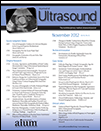Development of a Flexible Implantable Sensor for Postoperative Monitoring of Blood Flow
Abstract
We have developed a blood flow measurement system using Doppler ultrasound flow sensors fabricated of thin and flexible piezoelectric-polymer films. These flow sensors can be wrapped around a blood vessel and accurately measure flow. The innovation that makes this flow sensor possible is the diffraction-grating transducer. A conventional transducer produces a sound beam perpendicular to its face; therefore, when placed on the wall of a blood vessel, the Doppler shift in the backscattered ultrasound from blood theoretically would be 0. The diffraction-grating transducer produces a beam at a known angle to its face; therefore, backscattered ultrasound from the vessel will contain a Doppler signal. Flow sensors were fabricated by spin coating a poly(vinylidene fluoride–trifluoroethylene) copolymer film onto a flexible substrate with patterned gold electrodes. Custom-designed battery-operated continuous wave Doppler electronics along with a laptop computer completed the system. A prototype flow sensor was evaluated experimentally by measuring blood flow in a flow phantom and the infrarenal aorta of an adult New Zealand White rabbit. The flow phantom experiment demonstrated that the error in average velocity and volume blood flow was less than 6% for 30 measurements taken over a 2.5-hour period. The peak blood velocity through the rabbit infrarenal aorta measured by the flow sensor was 118 cm/s, within 1.7% of the measurement obtained using a duplex ultrasound system. The flow sensor and electronics operated continuously during the course of the 5-hour experiment after the incision on the animal was closed.




